Advertisements
Advertisements
Question
A body is in translational equilibrium under the action of coplanar forces. If the torque of these forces is zero about a point, is it necessary that it will also be zero about any other point?
Solution
Yes , if the torque due to forces in translation equillibrium is zero about a point, it will be zero about other point in the plane.
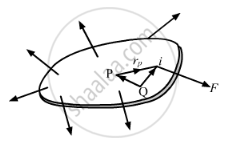
Let us consider a planner lamina of some mass, acted upon by forces \[\overrightarrow{F_1}, \overrightarrow{F_2}, . . . \overrightarrow{F_i},\] etc.
Let a force \[\overrightarrow{F_i}\] act on a \[i^{th}\] particle and torque due to \[\overrightarrow{F_i}\] be zero at a point Q.
Since the body is in translation equillibrium, we have
\[\Sigma \overrightarrow{F_i} = 0 .............(1)\]
Again, torque about P is zero . Therefore, we have
\[\Sigma\left( \overrightarrow{r_{pi}} \times \overrightarrow{F_i} \right) = 0 ..............(2)\]
Now, torque about point Q will be
\[\Sigma \overrightarrow{r}_{Qi} \times \overrightarrow{F_i} \]
\[ = \Sigma\left( \overrightarrow{r}_{QP} + \overrightarrow{r}_{Pi} \right) \times \overrightarrow{F_i} ............\left[\text{From fig.} \right]\]
\[ = \Sigma\left( \overrightarrow{r}_{QP} \times \vec{F_i} + \overrightarrow{r_{Pi}} \times \overrightarrow{F_i} \right)\]
\[ = \Sigma \overrightarrow{r_{QP}} \times \overrightarrow{F_i} + \Sigma \overrightarrow{r_{Pi}} \times \overrightarrow{F_i} \]
\[ = \overrightarrow{r_{QP}} \times \Sigma \overrightarrow{F_i} + 0 ..........\left[\text{From (2)} \right]\]
\[ = \overrightarrow{r_{QP}} \times 0 .........\left[\text{From (1)} \right]\]
\[ = 0\]
Thus, \[\overrightarrow{F}\] is zero about any other point Q.
APPEARS IN
RELATED QUESTIONS
A heavy particle of mass m falls freely near the earth's surface. What is the torque acting on this particle about a point 50 cm east to the line of motion? Does this torque produce any angular acceleration in the particle?
If several forces act on a particle, the total torque on the particle may be obtained by first finding the resultant force and then taking torque of this resultant. Prove this. Is this result valid for the forces acting on different particles of a body in such a way that their lines of action intersect at a common point?
A rectangular brick is kept on a table with a part of its length projecting out. It remains at rest if the length projected is slightly less than half the total length but it falls down if the length projected is slightly more than half the total length. Give reason.
When a body is weighed on an ordinary balance we demand that the arum should be horizontal if the weights on the two pans are equal. Suppose equal weights are put on the two pans, the arm is kept at an angle with the horizontal and released. Is the torque of the two weights about the middle point (point of support) zero? Is the total torque zero? If so, why does the arm rotate and finally become horizontal?
Equal torques act on the disc A and B of the previous problem, initially both being at rest. At a later instant, the linear speeds of a point on the rim of A and another point on the rim of B are \[\nu_A\] and \[\nu_B\] respectively. We have
A particle of mass m is projected with a speed u at an angle θ with the horizontal. Find the torque of the weight of the particle about the point of projection when the particle is at the highest point.
A particle is moving with a constant velocity along a line parallel to the positive X-axis. The magnitude of its angular momentum with respect to the origin is, ______
A rope is wound around a hollow cylinder of mass 3 kg and radius 40 cm. What is the angular acceleration of the cylinder if the rope is pulled with a force of 30 N?
What are the conditions in which force can not produce torque?
State conservation of angular momentum.
A particle of mass m is moving in yz-plane with a uniform velocity v with its trajectory running parallel to + ve y-axis and intersecting z-axis at z = a (Figure). The change in its angular momentum about the origin as it bounces elastically from a wall at y = constant is ______.
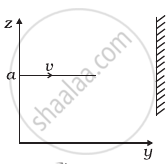
A uniform cube of mass m and side a is placed on a frictionless horizontal surface. A vertical force F is applied to the edge as shown in figure. Match the following (most appropriate choice):
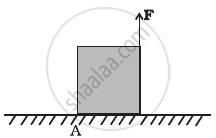
| (a) mg/4 < F < mg/2 | (i) Cube will move up. |
| (b) F > mg/2 | (ii) Cube will not exhibit motion. |
| (c) F > mg | (iii) Cube will begin to rotate and slip at A. |
| (d) F = mg/4 | (iv) Normal reaction effectively at a/3 from A, no motion. |
A door is hinged at one end and is free to rotate about a vertical axis (Figure). Does its weight cause any torque about this axis? Give reason for your answer.
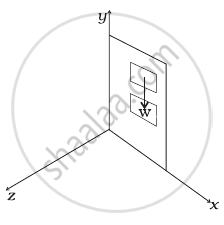
Two discs of moments of inertia I1 and I2 about their respective axes (normal to the disc and passing through the centre), and rotating with angular speed ω2 and ω2 are brought into contact face to face with their axes of rotation coincident.
- Does the law of conservation of angular momentum apply to the situation? why?
- Find the angular speed of the two-disc system.
- Calculate the loss in kinetic energy of the system in the process.
- Account for this loss.
A spherical shell of 1 kg mass and radius R is rolling with angular speed ω on horizontal plane (as shown in figure). The magnitude of angular momentum of the shell about the origin O is `a/3 R^2` ω. The value of a will be:
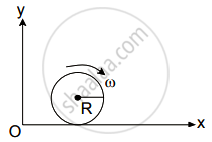
Angular momentum of a single particle moving with constant speed along the circular path ______.
